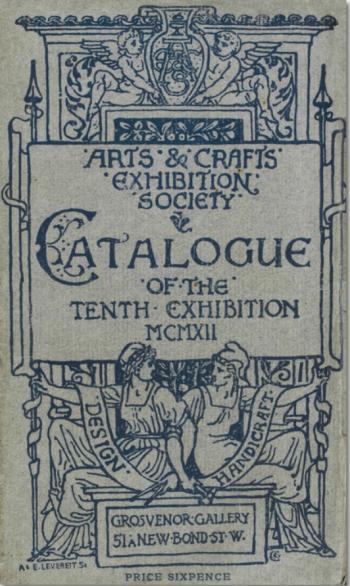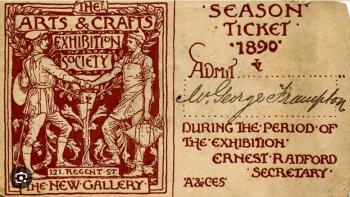Arts and Crafts Movement
A particularly English social movement of the second half, which began c. 1862 and lasted until the outbreak of World War I. The movement was dedicated to re-establishing the importance of craftsmanship in an era of growing mechanisation and mass production. The name derives from the Arts and Crafts Exhibition Society and was motivated by John Ruskin and other writers who deplored the effects of industrialisation. William Morris founded a group of interior designers and manufacturers to produce handmade textiles, printed books, wallpaper, furniture, jewellery and metalwork. The movement was criticised as elitist and unworkable in an industrial society, but in the 1890’s its appeal widened and spread to other countries, including the United States of America.
Arts and Crafts Exhibition Society
The Society was formed in London in 1887 by the principal protagonist, Walter Crane, its first President. Other illustrious members included William Morris (2nd President) and in the 21st Century, Sir Christopher Frayling. The Society's exhibitions were held annually at the New Gallery in Regent Street from 1888 to 1890, and roughly every three years thereafter. They were important in exposing to a large section of the public the British Arts and Crafts Movement in the decades before World War I. Other venues included the Grosvenor Gallery and the Royal Academy.
For about twenty years, the Society was a central campaigner for the ideals of the Arts and Crafts Movement in Britain, having been formed at a time when academic debate about art, craft and possible relationships with industrial production was beginning to emerge. Although the Society's exhibitions were regularly mounted in Britain from 1888, they also participated in international exhibitions overseas, including Turin in 1902, St. Louis in 1904, and Ghent in 1913. Key figures involved with the Society in its early years included its first President, artist and illustrator Walter Crane, metal worker William Arthur Smith Benson, author Lewis Foreman Day, architect John Dando Sedding, illustrator Heywood Sumner, and designer and illustrator Selwyn Image. Several publications disseminated the Society's viewpoint. The Society also published a periodical entitled Arts and Crafts Quarterly, but its timing, 1919-20, unfortunately, clashed with a lessening of its authority in the face of competition from such organisations as the Design and Industries Association and the British Institute of Industrial Art. In 1928, the Society opened its own showrooms at 34 Bloomsbury Street, London, where three floors were devoted to displaying the works of artists such as John Armstrong, Vanessa Bell and Duncan Grant.
The Society was truly multi-faceted and, over and above the usual painting, sculpting and printmaking disciplines, practitioners exhibited textiles, ceramics, furniture, metalwork, stained glass, bookbinding, woodworking, silversmithing and goldsmithing. The Society continued to exhibit periodically until the 1950's. In 1960, it merged with the Cambridgeshire Guild of Craftsmen to form the Society of Designer Craftsmen, which was still active into the millennium. Currently, practitioners and members number more than 350. In 1961, it changed its name to its present incarnation and is now known as the Society of Designer Craftsmen. The fundamental principle still remains one of having a selected membership whose work is based on creativity and originality, the inventiveness of design and the highest of standards.
Get Unlimited Access from just £5



